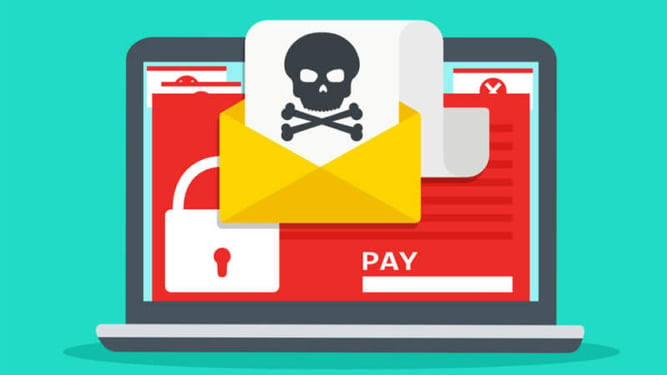REDWOOD LOGIN
Redwood PortalLTL
SCS
SCS Support
Rockfarm
Technology is not always the solution to today’s problems – sometimes it is the cause. A growing threat that the transportation industry faces is cyber-crime. Whether it’s the threat of scrupulous hackers gaining access to financial data, or a virus impacting a transportation’s cloud-based CRM, companies of all size and scope all face challenges. One of the fastest-growing online threats is known as ransomware – a malicious software that holds a company hostage through extortion and can completely shut down their operations.
Ransomware is a malicious software that attacks a computer network or server, then spreads to hardware devices including desktops, laptops, tablets and mobile devices. Huge companies like FedEx, Deutsche Bahn, and Maersk have all fallen victim to ransomware attacks in the past five years. Once the ransomware has embedded inside of a computer network, it spreads to all devices or users who connect to this system. In some cases, this cyber-attack will impact third-parties who connect to a company’s website or their cloud-based CRM systems.
Once the ransomware has been embedded to a company’s computer network, a ‘ransom note’ for lack of a better term, alerts the infected user's device (the user using it) that they need to provide an online, non-traceable payment to remove the virus. If the demand is not met, the ransomware virus will begin to corrupt files – and render the system useless and non-accessible. The result of this type of scrupulous activity is that the infected party is forced to spend hundreds of thousands to millions of dollars on replacing and rebuilding their computer network – which can shut down a logistics company completely.
There are several reasons why transportation companies specifically, are ripe targets for ransomware cyber-attacks:
• Their dependence on computer and online connectivity: Most ransomware attacks target industries that depend on efficient computer network connectivity to operate their business. With most transportation companies setting up and managing logistics via their computers and online networks, it makes them a target of these attacks. Since the company needs their computers to run smooth, many of them will willingly pay the ransom quickly to continue their operations.<
• There are multiple opportunities to hack the system: Logistics companies have a highly-connective network of computer-based systems, many of which are vulnerable to cyber-attacks. The hackers find a weak link within the network, and can gain entry, then quickly spread the ransomware throughout the entire system.
• Many transportation companies can’t afford or don’t invest in Cyber Security: While there are many operational costs – investing in cybersecurity infrastructure isn’t on top of the list. However, when a company is attacked, and they realize the cost of trying to resolve this issue, cybersecurity quickly gains momentum.
 Contrary to popular belief, transportation and logistics companies don’t need to wait to fall victim to cyber-Armageddon. In fact, there are several ways they can fight back and protect themselves against this growing threat.
Contrary to popular belief, transportation and logistics companies don’t need to wait to fall victim to cyber-Armageddon. In fact, there are several ways they can fight back and protect themselves against this growing threat.
Like any type of virus, the key to stopping the spread is blocking the point of entry. The first step that any transportation company can employ is to educate all users as to the techniques that hackers use to gain access to the company’s computer system. This is known as cyber-security hygiene. Most hackers will break into a computer network through three common sources:
• An embedded email link: This is the most common source of any cyber-attack. The hacker will send an email with related content targeted to the company, with an embedded link within the email that requires a ‘click’ to access more information. When any user within the network clicks the link, it is forwarded to a hosted network, where the virus is held and begins to download onto the individual computer. Once it’s infected on a computer, it can spread through the server via the internet connection.
• A less-than-trustworthy website: There are several websites or blogs that post news stories that are topical to pop-culture. These sites often post “top 10” or celebrity gossip “news” to attract site visitors. Once the site is accessed, it can download corrupted files onto the user computer, and then the entire network.
• A corrupted attachment: The third most common source of cyber-attacks are attachments that are sent through email or other downloadable files. These files can come from third-parties who send files to a company.
A good cyber-security program starts with education for all users on how to avoid these three possible issues. Make sure they are trained to not click links from emails, not to visit non-work-related websites (especially entertainment websites), and to only download attachments from trusted sources.
Most computers (especially on a professional level) come with malware and cyber-security software. While it’s vital to utilize these systems – it’s more important to update files when they are offered by the manufacturer. For those who use PC’s with Windows, make sure to always update files and programs as they are available. Apple users should also download or update their iOS systems when they are offered. If you have an online security program from a third-party vendor like Comodo, Norton, and others, it's important to update as well.
Any smart business understands the importance of risk analysis. When you consider the ‘cost’ of having an entire computer network hacked, customer files corrupted, and downtime trying to resolve and repair the network, it’s clear that being proactive about cyber-security and education is the smart way to reduce the potential of falling victim to ransomware.